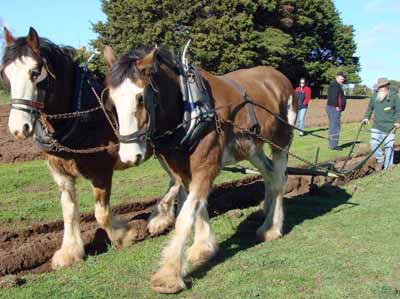Practical Work Horses
 1. Mounted Police 1. Mounted Police
Police who do patrols on horse, or camel, back
are known as mounted police. Though they may look simply ceremonial, they are very useful in crowd control
situations because of their mass and height advantage and are being used with increasing frequency in the
UK as crime prevention patrols. They can be seen patrolling parks and wilderness where a car or other
automobile is not practical to crowd control where their size intimidates and can be used to pick trouble
makers out of a crowd. There are some branches of mounted police that are trained in search and rescue
thanks to the horses ability to travel where many vehicles cannot.
2. Driving
Driving is a broad term used to describe the
hitching of a horse to a wagon, carriage, sleigh, or other horse-drawn vehicle. It is a term that covers
everything from pleasure driving, to farm work, and even harness racing. Horses may be harnessed in a number of
ways; when working they are often hook to a plow or other farm equipment and in many parts of the world they
still pull carts, wagons, boats through locks and logs. They are also often seen pulling monarchs through the
streets, such as when the Queen of England is trooping the colour.
3. Trail Riding
Trail riding is riding outdoors on natural
trails and roads as opposed to in an arena. They are often informal activities, large events or parts of guest
ranches. There are competitive events available, but most often it is simply a form of pleasure riding where
speed and form are not the goal but fun and enjoyment are. Trail riding may go hand in hand with camping,
hunting or fishing. There can be conflict between hikers, nature preservists, and trail riders as there have
been complaints from the former about noxious seed spreading and cluttering up of hiking trails, but for the
most part everyone appears to get along and simply enjoy the outdoors.
4. Therapy
Therapy horses are used to teach riding skills
to people with disabilities and are beneficial for children and adults with a wide range of cognitive, physical
and emotional conditions. A program must be administered by a certified instructor following a patient
assessment. Working with horses teaches more than riding skills, it also teaches companionship, responsibility,
confidence, leadership and life skills. Many form a deep bond of attachment with their horses and through this
begin to heal and develop and extend this development to others around them.
5. Farming
Horses are not commonly used in farming in most
first world societies, but in some third world countries and some first world communities do use them for work
animals. Common uses on a farm include ploughing, in which a horse is hitched up to a plough and used to create
trenches for planting in a field. They may also be used as hunting or draft animals or to pull carts for
carrying goods to market.
Related Articles
Famous Horses In Fiction
Five Famous Warhorses
5 Sports Horses Participate In
Horses in Warfare
Non-Horses
Practical Work Horses
How to Tell Your Horse's Age By Their
Teeth
How Smart Are Horses?
Gallopers
Why Are Unicorns So Popular and Could
They Really Exist?
The Role of Horses in Human
Advancement
|